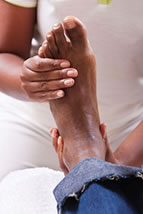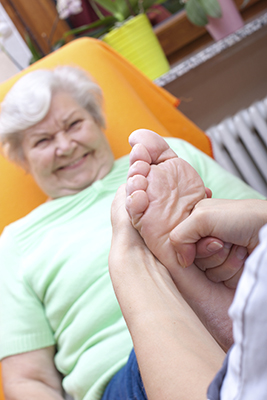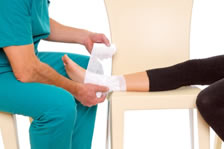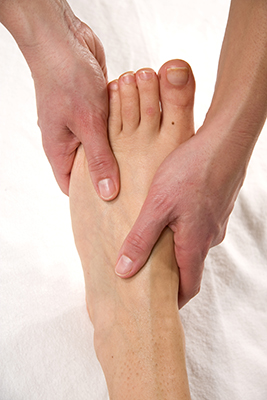
Greater Queens Podiatry, PLLC
 (718) 229-0222
(718) 229-0222
 (718) 229-0222
(718) 229-0222 Amari Cooper was suffering from a foot injury when he became “the first rookie in Oakland Raiders history to reach 1,000 receiving yards.” Cooper played throughout most of the 2015 season with plantar fasciitis, a condition that caused him foot pain. However, Cooper was confident in his ability to play. “[I]t really affected my game, but I was mentally tough and I fought through it,” he said.
Amari Cooper was suffering from a foot injury when he became “the first rookie in Oakland Raiders history to reach 1,000 receiving yards.” Cooper played throughout most of the 2015 season with plantar fasciitis, a condition that caused him foot pain. However, Cooper was confident in his ability to play. “[I]t really affected my game, but I was mentally tough and I fought through it,” he said.
Sports related foot and ankle injuries need proper treatment before players can go back to their regular routines. For more information, contact Dr. Nicholas Megdanis from Greater Queens Podiatry PLLC. Our doctor can provide the care you need to keep your pain free and on your feet.
Sport Related Foot and Ankle Injuries
Foot and ankle injuries are a common occurrence when it comes to athletes of any sport. While many athletes dismiss the initial aches and pains, the truth is that ignoring potential foot and ankle injuries can lead to serious problems. As athletes continue to place pressure and strain the area further, a mild injury can turn into something as serious as a rupture and may lead to a permanent disability. There are many factors that contribute to sports related foot and ankle injuries, which include failure to warm up properly, not providing support or wearing bad footwear. Common injuries and conditions athletes face, including:
● Plantar Fasciitis
● Plantar Fasciosis
● Achilles Tendinitis
● Achilles Tendon Rupture
● Ankle Sprains
Sports-related injuries are commonly treated using the RICE method. This includes rest, applying ice to the injured area, compression and elevating the ankle. More serious sprains and injuries may require surgery, which could include arthroscopic and reconstructive surgery. Rehabilitation and therapy may also be required in order to get any recovering athlete to become fully functional again. Any unusual aches and pains an athlete sustains must be evaluated by a licensed, reputable medical professional.
If you have any questions please contact our offices located in Bayside, New York. We offer the newest diagnostic and treatment technologies for all your foot and ankle needs.
Foot and ankle injuries are common among people who participate in sports. Several factors contribute to this. They include failing to stretch or warm up properly, not wearing the proper type of shoe and not taping or providing other types of support for the ankle or foot. The most common foot and ankle injuries suffered by people involved in sports are plantar fasciitis, ankle sprains and Achilles tendon damage or ruptures. If not treated properly, they can lead to permanent disability.
Treating these injuries is relatively simple if they are identified and addressed early. Many athletes dismiss the initial aches and pains associated with injury as just soreness or tired muscles. Their first response is usually to try to work through it. This can lead to serious problems. Many minor injuries are made far more serious when athletes continue to put strain and pressure on them. That attitude can change a mild strain into a serious strain and a minor tear into a rupture. Athletes should have unusual aches and pains evaluated by a skilled medical professional.
Plantar fasciitis is a painful injury. It is inflammation of the plantar fascia, the thick band of tissue running from the heel to the base of the toes. If left untreated, it can lead to a degenerative disease called plantar fasciosis. There are several effective treatments for this ailment. Doctors often prescribe rest, massages, stretching, night splints, physical therapy, anti-inflammatory medication, corticosteroids or surgery, usually in that order. The most effective treatment for plantar fasciitis is orthotics, which offers foot support. Surgery is occasionally used as a last resort, but it comes with the risk of nerve damage and infection and often does not stop the pain.
The Achilles tendon is the largest tendon in the body. It connects the calf muscles to the heel bone. Running, jumping and walking all impact this tendon. Two common injuries to the Achilles tendon are tendonitis and a rupture of the tendon. Tendonitis is inflammation in the tendon often caused by an increase in the amount of stress placed on it. Non-surgical treatments include rest, ice or anti-inflammatory medication. A rupture (tear) of the Achilles tendon can be treated by placing the lower leg in a cast for several weeks or with surgery. Many physicians feel surgery is the better option because it lowers the risk of re-ruptures. Both methods require 4 to 6 months of rehabilitation.
Ankle sprains are the most common sports related foot and ankle injury. A sprain occurs when the ligament holding the ankle bones and joint stretches beyond its normal range. It can be treated non-surgically with a combination of rest, ice wrapped around the joint for 30 minutes immediately after injury, compression by a bandage and elevating the ankle above the heart for 48 hours. This combination is referred to as RICE. Severe ankle sprains in which the ligaments are torn may require reconstructive surgery followed by rehabilitation.
 It is important for people with diabetes to take extremely good care of their feet. Scientific research has been done to figure out why diabetics tend to have foot problems. Researchers have found that neuropathy, or nerve damage, can prevent an individual from being able to sense pain in their feet. Fortunately, there are ways to prevent foot-related diabetic complications from happening. Having good control of your blood sugar will protect viral nerve function. A lot of problems can also be prevented by simply having a healthy lifestyle, and getting routine check-ups.
It is important for people with diabetes to take extremely good care of their feet. Scientific research has been done to figure out why diabetics tend to have foot problems. Researchers have found that neuropathy, or nerve damage, can prevent an individual from being able to sense pain in their feet. Fortunately, there are ways to prevent foot-related diabetic complications from happening. Having good control of your blood sugar will protect viral nerve function. A lot of problems can also be prevented by simply having a healthy lifestyle, and getting routine check-ups.
Diabetic foot care is important in preventing foot ailments such as ulcers. If you are suffering from diabetes or have any other concerns about your feet contact Dr. Nicholas Megdanis from Greater Queens Podiatry PLLC. Our doctor can provide the care you need to keep your pain free and on your feet.
Diabetic Foot Care
Diabetes affects millions of people every year. Diabetes can damage blood vessels in many parts of the body, including the feet. Because of this, taking care of your feet is essential if you have diabetes, and having a podiatrist help monitor your foot health is highly recommended.
The Importance of Caring for Your Feet
● Routinely inspect your feet for bruises or sores.
● Wear socks that fit your feet comfortably.
● Wear comfortable shoes that provide adequate support.
Patients with diabetes should have their doctor monitor their blood levels because blood sugar levels play such a huge role in diabetic care. Monitoring these levels on a regular basis is highly advised.
It is always best to inform your healthcare professional of any concerns you may have regarding your feet, especially for diabetic patients. Early treatment and routine foot examinations are keys to maintaining proper health, especially because severe complications can arise if proper treatment is not applied.
If you have any questions please feel free to contact our offices located in Bayside, NY. We offer the newest diagnostic and treatment technologies for all your foot and ankle needs.
 Matt McCown, junior defensive tackle for Illinois State, was sidelined for six weeks with a broken foot. McCown started 9 out of 12 games last season. ISU coach Brock Spack was hopeful that McCown would recover in time to play in the game against North Dakota state in October. “Matt is really a leader, a hard worker,” Spack said. “You hate to lose him. But the good news is we’ll get him back.”
Matt McCown, junior defensive tackle for Illinois State, was sidelined for six weeks with a broken foot. McCown started 9 out of 12 games last season. ISU coach Brock Spack was hopeful that McCown would recover in time to play in the game against North Dakota state in October. “Matt is really a leader, a hard worker,” Spack said. “You hate to lose him. But the good news is we’ll get him back.”
A broken foot requires immediate medical attention and treatment. If you need your feet checked, contact Dr. Nicholas Megdanis from Greater Queens Podiatry PLLC. Our doctor can provide the care you need to keep your pain free and on your feet.
Broken Foot Causes, Symptoms, and Treatment
A broken foot is caused by one of the bones in the foot typically breaking when bended, crushed, or stretched beyond its natural capabilities. Usually the location of the fracture indicates how the break occurred, whether it was through an object, fall, or any other type of injury.
Common Symptoms of Broken Feet:
Bruising
Pain
Redness
Swelling
Blue (foot)
Numbness
Cold
Misshapen
Cuts
Deformities
Those that suspect they have a broken foot shoot seek urgent medical attention where a medical professional could diagnose the severity.
Treatment for broken bones varies depending on the cause, severity and location. Some will require the use of splints, casts or crutches while others could even involve surgery to repair the broken bones. Personal care includes the use of ice and keeping the foot stabilized and elevated.
If you have any questions please feel free to contact one of our offices located in Bayside, NY. We offer the newest diagnostic and treatment technologies for all your foot and ankle needs.
 Plantar Fasciitis is a very common cause of heel pain. The condition causes severe heel pain within the first few steps one takes in the morning, and it is also causes pain during activity. Fortunately, there are treatment options for people with plantar fasciitis. Some options for those with plantar fasciitis include medications, shoe inserts, and stretching. ITU technology has also been used to help those with pain in their heels. ITU, which stands for intense therapeutic ultrasound, heals musculoskeletal injuries without breaking the skin.
Plantar Fasciitis is a very common cause of heel pain. The condition causes severe heel pain within the first few steps one takes in the morning, and it is also causes pain during activity. Fortunately, there are treatment options for people with plantar fasciitis. Some options for those with plantar fasciitis include medications, shoe inserts, and stretching. ITU technology has also been used to help those with pain in their heels. ITU, which stands for intense therapeutic ultrasound, heals musculoskeletal injuries without breaking the skin.
Anyone can wind up suffering from heel pain. For more information, contact Dr. Nicholas Megdanis from Greater Queens Podiatry PLLC. Our doctor will treat your foot and ankle needs.
Causes of Heel Pain
● Heel pain is often associated with plantar fasciitis. The plantar fascia is a band of tissues that extends along the bottom of the foot. A rip or tear in this ligament can cause inflammation of the tissue.
● Achilles tendonitis is another cause of heel pain. Inflammation of the Achilles tendon will cause pain from fractures and muscle tearing. Lack of flexibility is also another symptom.
● Heel spurs are another cause of pain. When the tissues of the plantar fascia undergo a great deal of stress, it can lead to ligament separation from the heel bone, causing heel spurs.
Why Might Heel Pain Occur?
- Wearing ill-fitting shoes
- Wearing non-supportive shoes
- Weight change
- Excessive running
Treatments
Heel pain should be treated as soon as possible for immediate results. Keeping your feet in a stress free environment will help. If you suffer from Achilles tendonitis or plantar fasciitis, applying ice will reduce the swelling. Stretching before an exercise like running will help the muscles. Using all these tips will help make heel pain a thing of the past.
With the advancements in technology and greater knowledge of how muscles and joints work, physical therapists can turn things around dramatically.
If you have any questions, please feel free to contact our office located in Bayside, NY. We offer the newest diagnostic and treatment technologies for all your foot and ankle needs.
Have you ever gotten up from a chair or out of bed in the morning, and upon taking that first step, feel like your heel has stepped on a tack? Many people experience a feeling of sharp pain which radiates into their arch from their heel and which does not allow them to put their heel on the floor. Sometimes they need to sit back down, stand only on their toes and use the wall for balance. If you can take a few steps, it seems to go away and lessens, allowing you then to resume your activity. Later, throughout your day and after a period of rest, it can happen again. If this sounds familiar you may be suffering from your first attack of heel pain.
Heel pain is a debilitating condition that affects day to day activities. Running and walking both causes stress on the heel because the heel is the part of the foot that hits the ground first. This means that the heel is taking on your entire weight. Diagnosis and treatments for heel pain can be easily found through your podiatrist.
Plantar Fasciitis
One of the main causes of heel pain is a condition known as plantar fasciitis. The plantar fascia is a band of tissue that extends along the bottom of the foot, from the toe to the bottom of the heel. A rip or tear in this ligament can cause inflammation of these tissues, resulting in heel pain. People who do not wear proper fitting shoes are often at risk of developing problems such as plantar fasciitis. Unnecessary stress from ill-fitting shoes, weight change, excessive running, and wearing non-supportive shoes on hard surfaces are all causes of plantar fasciitis.
Achilles Tendonitis
Achilles tendonitis is another cause of heel pain. Similar to plantar fasciitis, inflammation of the Achilles tendon will cause heel pain due to stress fractures and muscle tearing. A lack of flexibility of the ankle and heel is an indicator of Achilles tendonitis. If left untreated, this condition can lead to plantar fasciitis and cause even more pain on your heel.
Heel Spur
A third cause of heel pain is a heel spur. A heel spur occurs when the tissues of the plantar fascia undergo a great deal of stress, leading to a separation of the ligament from the heel bone entirely. This results in a pointed fragment of bone on the ball of the foot, known as a heel spur.
 Plantar warts develop on the bottom of our feet as round growths on the skin, described as brown dots. Warts are caused by the papillomavirus and usually go away on their own, typically not requiring any treatment. Avoid picking at the wart to prevent infection. A potential option for treating your wart is covering it up with tape, as “warts deprived of air and sun exposure sometimes die without the need for topical treatments.”
Plantar warts develop on the bottom of our feet as round growths on the skin, described as brown dots. Warts are caused by the papillomavirus and usually go away on their own, typically not requiring any treatment. Avoid picking at the wart to prevent infection. A potential option for treating your wart is covering it up with tape, as “warts deprived of air and sun exposure sometimes die without the need for topical treatments.” Kekuta Manneh, forward of the Vancouver Whitecaps, recently underwent surgery to repair a broken fifth metatarsal bone in his right foot. A timetable for his return was not released by the team, however head coach Carl Robinson has suggested Manneh can return this season. “Kekuta is an important member of the club and we’re happy to hear the surgery went well,” Robinson stated. “We anticipate he will make a complete recovery and will be back training with the group in the fall." This season Manneh has scored five goals and had two assists.
Kekuta Manneh, forward of the Vancouver Whitecaps, recently underwent surgery to repair a broken fifth metatarsal bone in his right foot. A timetable for his return was not released by the team, however head coach Carl Robinson has suggested Manneh can return this season. “Kekuta is an important member of the club and we’re happy to hear the surgery went well,” Robinson stated. “We anticipate he will make a complete recovery and will be back training with the group in the fall." This season Manneh has scored five goals and had two assists. | Bayside Office 4401 Francis Lewis Blvd Suite L3B Bayside, NY 11361 Phone: (718) 229-0222 Fax: (718) 717-0275 | Monday: 9:30am - 7pm |
E-mail us with any questions